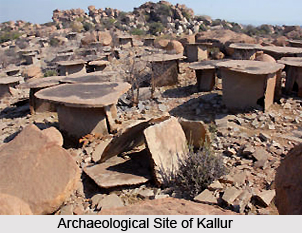 Kallur is a well-known archaeological site which is present in Manvi taluk, Raichur District, in the southern Indian state of Karnataka. The site of Kallur achieved fame immediately following the discovery of beautiful `antennae swords` during the era of 1930`s, which were the instances of the culture of `Copper Hoard` in the southern portion of India. The earliest archaeological evidences unearthed from Kallur can be traced back to the Neolithic Age.
Kallur is a well-known archaeological site which is present in Manvi taluk, Raichur District, in the southern Indian state of Karnataka. The site of Kallur achieved fame immediately following the discovery of beautiful `antennae swords` during the era of 1930`s, which were the instances of the culture of `Copper Hoard` in the southern portion of India. The earliest archaeological evidences unearthed from Kallur can be traced back to the Neolithic Age.
The term `Kallur` is a derivation from two Kannada words consisting of `kallu` implying stone and `ooru` implying `town`. Numerable granite hills are located near Kallur, which might have attributed to its present name. `Polannagudda`, `Agsargudda`, `Kampangudda`, `Yammigudda` and `Pirbannur` are some of the hillocks.
Archaeological Remnants at Kallur
The earliest excavations conducted at Kallur were supervised by the Archaeological Department of Hyderabad, in the era of 1939 to 1940. M. Khwaja Ahmed was responsible for these excavations. In the year 1952, F. Raymond Allchin later volunteered to carry further explorations at Kallur. Three antennae swords have been found under a boulder by the regional inhabitants of a nearby village, particularly on the hillock of Pirbannur during 1930`s. Cast copper was the building material of these ancient swords with antennae measuring about 6 centimetres to 7 centimetres in length. The shortest sword with antenna is of 68 centimetres in length while the longest one measures 98 centimetres in length, bearing a close resemblance to those uncovered at Copper Hoard in northern India.
The ancient paintings which are unearthed from Kallur, one of the most precious archaeological sites in Karnataka of miniature bulls, buffaloes, a human figure, etc. are found on the Yammigudda hillock situated here. One will also find beautiful russet-coated painted artefacts in this area. A large variety of unique objects have been uncovered at Kallur site which includes shell bangles, stone axes, beads composed of semi-precious stones, chalcedony, jasper and chert. The presence of quartzite and iron ore found here bears testimony to the fact that a crude form of iron smelting used to be practised in this area. Other interesting objects which have been discovered are the coins belonging to the Satavahana Dynasty.



















